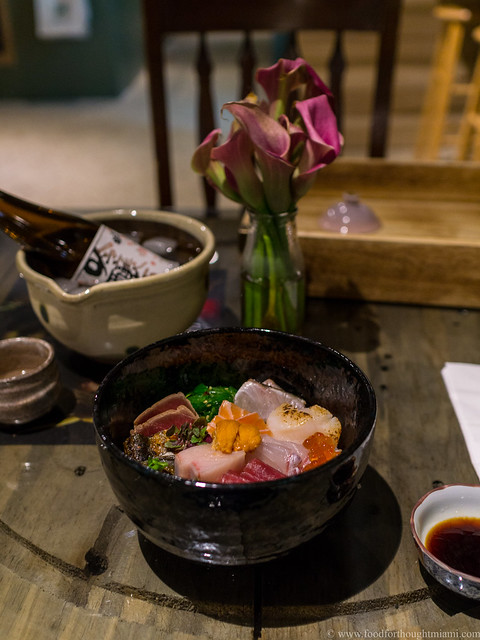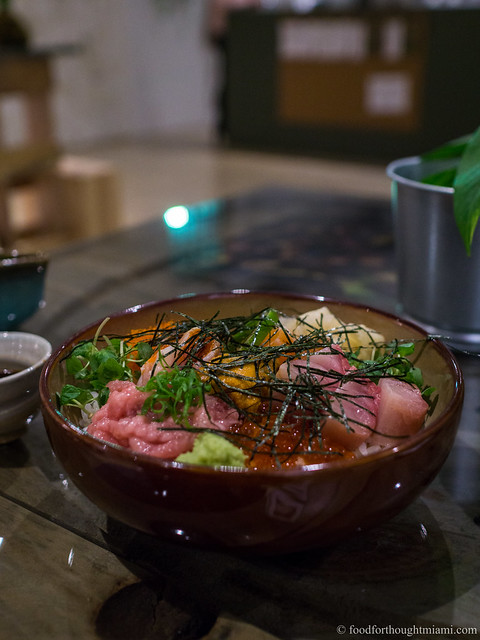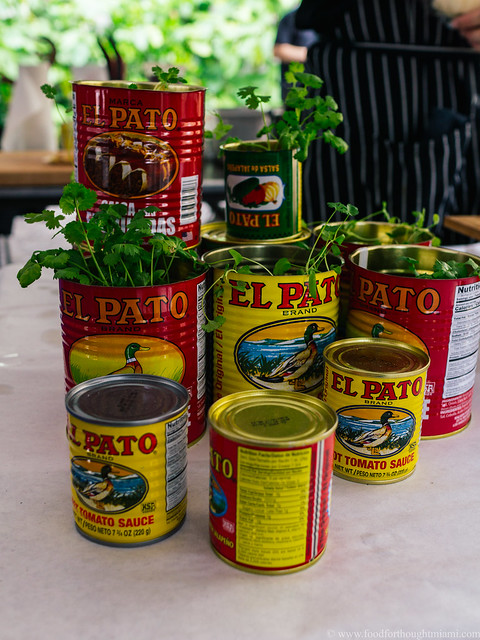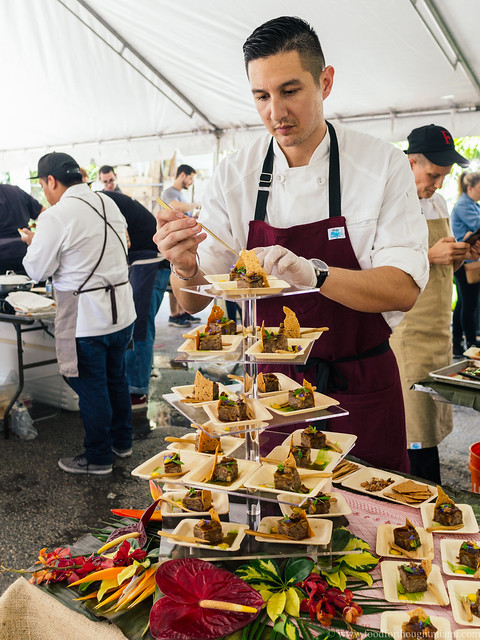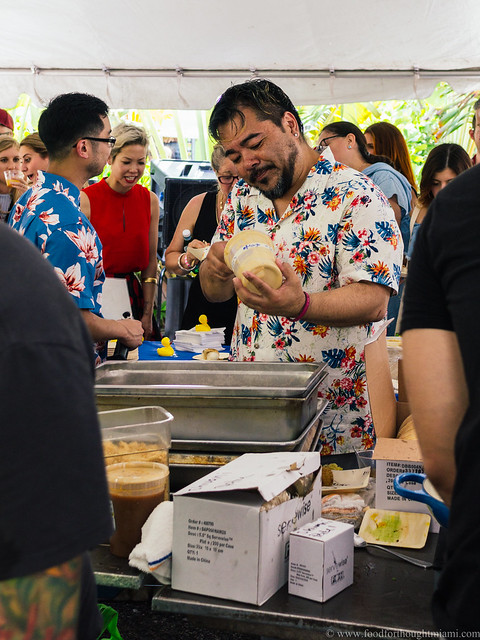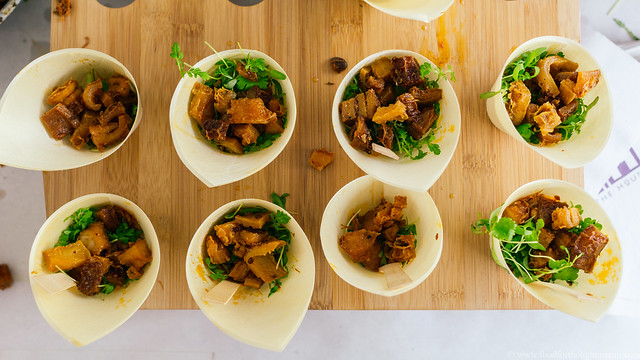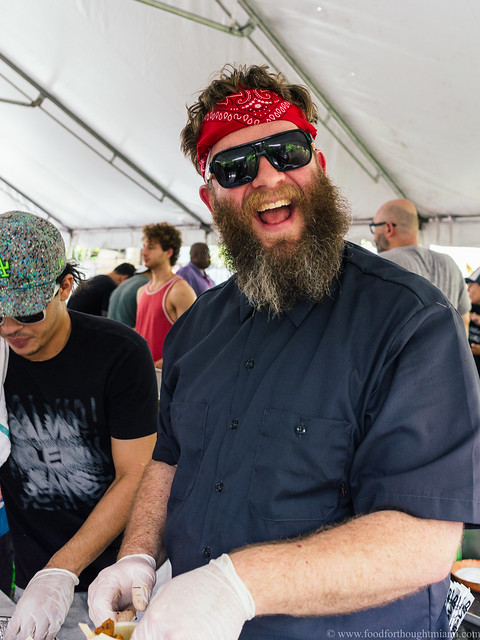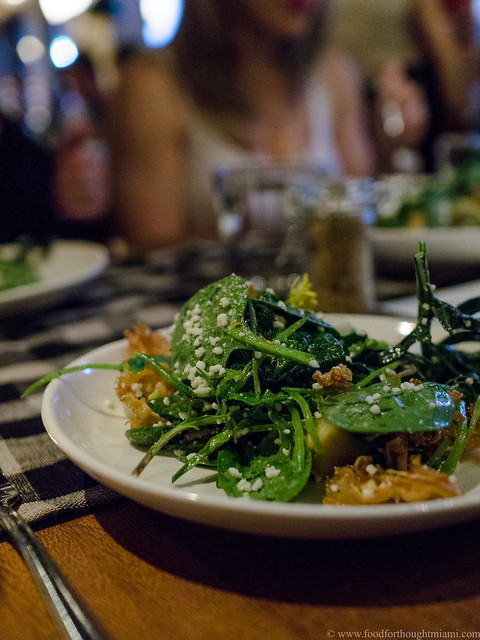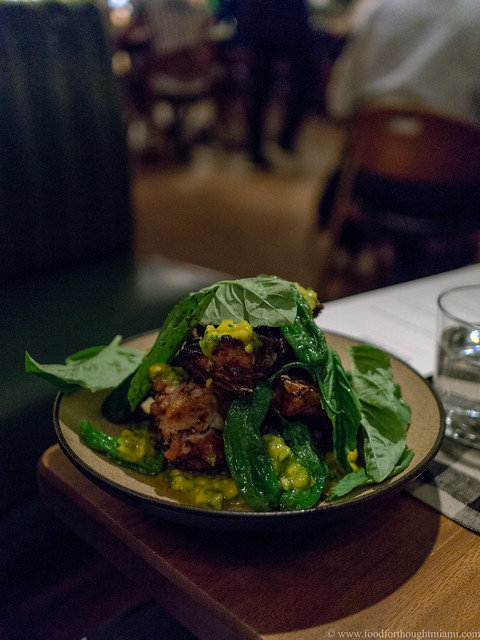My first taste of chef Shuji Hiyakawa's food came at an event last spring hosted by the Japanese Consulate in Miami, described as "Culinary Secrets of Traditional Washoku." "Washoku" literally means "Japanese food," but more specifically, the traditional cuisine of Japan (here's a good primer). After breaking down a whole tuna loin and making sushi of it, Chef Shuji also served a variety of other less heralded Japanese items: a seasonal dish of hotaru ika (firefly squid) with fresh bamboo shoots, yu choy in dashi broth with bonito flakes, sweet soy-braised root vegetables.
At the time, Chef Shuji, who made his way from Fukuoka, Japan to Miami by way of Philadelphia, where he had worked for several years as executive sushi chef for Morimoto, was weeks away from opening his own restaurant, Dashi. I went to Dashi shortly after it opened (you can read my first thoughts) and came away pretty impressed, albeit dismayed by the absence of a conventional sushi bar. But Dashi closed only a few months later after Hurricane Irma caused extensive damage to the River Yacht Club, where the restaurant was situated.
Fortunately, Chef Shuji had a back-up plan. Turns out he was already at work on another concept in a different space – and even better (for me, anyway), it was right along the path of my daily commute, in Miami's "Upper East Side" on N.E. 79th Street just over the Causeway from Miami Beach. In early January, Wabi Sabi by Shuji opened.
(You can see all my pictures in this Wabi Sabi by Shuji flickr set).
It's a simple but striking space, built out and decorated almost entirely by Chef Shuji himself. Across one wall sprawls a flock of multi-colored origami cranes. A table underneath is laid out with enough beautiful Japanese ceramics to serve a feast for about ten people (more on that later). Hanging from the ceiling and resting on counters are an abundance of kokedama moss ball planters. A few rough wood tables provide seating for maybe a dozen diners. At the back, there's a small kitchen island where you'll find Chef Shuji and assistant chef Maggie Hyams working away, and on some days, marketing and event coordinator Koko Makoto working the register, serving as hostess, and doing everything else that needs doing with grace and charm.
There's still no sushi bar. Rather, the idea of Wabi Sabi combines some Japanese tradition with the latest in American fast-casual trends: food in bowls. We all love food in bowls these days. Buddha bowls, poke bowls, power bowls, acai bowls – seems we'll eat anything if you put it in a bowl.[1] While some food trends are just plain stupid, this is one I can get behind: it's convenient, it's right-sized portioning, and when you put nice things in the bowl, it can be both delicious and aesthetically pleasing.
Which are also some of the things I love about Wabi Sabi. The menu at Wabi Sabi is straightforward: a choice of four different combinations of raw fish and accompaniments, over a choice of four different bases (sushi rice, a multigrain mixture, green tea soba noodles, or salad greens), with a choice of four different sauces – served in a bowl.[2] Any of the basic configurations will run you between $11 (for a vegetarian version which includes cucumber, avocado, scallion, seaweed salad, soy-marinated shiitake mushrooms, carrots and radishes) and $18 (for a fully decked out version with tuna, salmon, lump crab, tobiko, and an assortment of vegetables).
Or, for the ballers out there, there's also an "omakase" bowl, which features an ever-changing assortment of fish and seafood, much of it flown in straight from Tsukiji Market in Japan, served chirashi style over seasoned rice. That may mean blocks of fatty hamachi (yellotwail), ribbons of silky, clean kinmedai (golden-eye snapper), shimmering sayori (half-beak), creamy uni (sea urchin), silver-skinned aji (horse mackerel), house-cured iwashi (sardine) or kohada (gizzard shad), baubles of ikura (salmon roe), or any number of other possibilities, served over a bowl of seasoned rice, with seaweed salad, maybe some sprouts, maybe some soy-cured shiitake mushrooms, and a scatter of shredded nori batons.
Unlike the standard menu options, the omakase bowl is not cheap – pricing usually runs between $35 and $40, depending on what ingredients are featured that particular day. But if you add up what you would pay for a comparable sashimi or sushi order at any good sushi-ya – and the quality of the ingredients at Wabi Sabi is on par with what you'll find at the few places in Miami that fit that description – I think you'll find it to be roughly equivalent. It is also probably the easiest, most convenient way to eat some great sushi that you'll find in Miami, one that you can even take home and eat in front of the TV if you wish.
(continued ...)
Friday, June 15, 2018
Monday, May 28, 2018
Duck Duck Goose Trois at The Anderson
I've said here often that P.I.G. - Pork Is Good, Jeremiah Bullfrog's locally grown celebration of all things porcine, has become my favorite Miami food event. A few years ago he added a spin-off – Duck Duck Goose, starring the one protein that may come close to rivaling pork's range, versatility and deliciousness: duck. The inaugural DDG in 2016 was a blast, but I sadly missed Number 2. The birds were back for Duck Duck Goose Trois this past Sunday afternoon.
(You can see all my pictures in this Duck Duck Goose Trois flickr set.)
It didn't look like good flying weather for ducks Sunday morning, with Subtropical Storm Alberto creating a wet and windy maelstrom. But somehow, like the eye of the storm, a perfect little window of calm, sunny weather opened up at just the right time. The festivities, hosted by The Anderson bar on Miami's Upper East Side, went off without a hitch. Here are some highlights:
Duck terrine with a wild mushroom gelée, pickled sunchokes, smoked duck egg yolk and duck chicharrones from David Coupe and Josue Peña of Faena. Really beautiful technique and great flavors.
Torched miso and duck fat onigiri stuffed with miso seasoned slow cooked duck, from Katsuya Fukushima of Washington DC's Daikaya – very possibly my favorite bite of the day.
Fuqi Feipian – literallly "husband and wife lung" – done here as crispy tripe and confit duck wings laced with Szechuan chili oil from Jeremiah Bullfrog. A close rival for my favorite bite of the day, given my penchant for tripe.
(continued ...)
(You can see all my pictures in this Duck Duck Goose Trois flickr set.)
It didn't look like good flying weather for ducks Sunday morning, with Subtropical Storm Alberto creating a wet and windy maelstrom. But somehow, like the eye of the storm, a perfect little window of calm, sunny weather opened up at just the right time. The festivities, hosted by The Anderson bar on Miami's Upper East Side, went off without a hitch. Here are some highlights:
Duck terrine with a wild mushroom gelée, pickled sunchokes, smoked duck egg yolk and duck chicharrones from David Coupe and Josue Peña of Faena. Really beautiful technique and great flavors.
Torched miso and duck fat onigiri stuffed with miso seasoned slow cooked duck, from Katsuya Fukushima of Washington DC's Daikaya – very possibly my favorite bite of the day.
Fuqi Feipian – literallly "husband and wife lung" – done here as crispy tripe and confit duck wings laced with Szechuan chili oil from Jeremiah Bullfrog. A close rival for my favorite bite of the day, given my penchant for tripe.
(continued ...)
Wednesday, April 4, 2018
Cobaya Upland with Justin Smillie
When I first heard that Upland was opening in Miami Beach, the place was something of an enigma to me. I thought of Justin Smillie as a New York City chef (one whose NYC restaurant, also named Upland, I'd never tried), but the menu felt like it came from the other coast. As it turns out, Upland is a town in San Bernardino County inland of Los Angeles where Smillie was born, and his cooking style is indeed very much inspired by the "California cuisine" idiom: seasonal, vegetable forward, casual in presentation but still precise in execution.
The South of Fifth spot, which Smillie opened with restaurateur Stephen Starr (whose Miami products also include Makoto and Le Zoo) has become one of my favorites among the latest crop of "Sixth Borough" restaurants in Miami. I love the dining room, designed by Roman & Williams, with its green leather banquettes and walls lined with backlit jars of preserved lemons. But even more, I love the food, whose superficial simplicity usually belies a sonorous depth of flavor.
We were eager to do a Cobaya dinner with him, and the interest was mutual, but since Smillie is not in South Florida regularly this was a challenging one to schedule. We finally lined up a date, and even though it was only a week after our last event, we jumped on the opportunity.
As always, our request to the chef was simple: do whatever you want, just don't do anything on your regular menu. Smillie's response was entirely off-menu, but also entirely in keeping with the spirit of his restaurant.[1] Here's what he made:
(You can see all my pictures in this Cobaya Upland with Chef Justin Smillie flickr set).
Smillie started things off with a salad – served family style – and my immediate reaction was, "It's not going to be as good as his little gem salad," a combination of perky gem lettuce, avocado, cucumber, and shaved ricotta salata in a walnut vinaigrette that hits all the right notes for me. I was wrong. This was every bit its equal. Here were all sorts of early spring things: tender spinach leaves, asparagus, fava beans, artichokes, frilly little mushrooms that were crispy like croutons. Crumbled cotija cheese added some creamy richness, a precisely balanced vinaigrette added structure and brightness.
Mrs. F thinks I hate salads. I don't. A good salad makes me very happy, and this was a very good salad.[2]
Spring is also the season for soft shell crabs, when they molt from their hard exoskeletons and basically the whole critter can be eaten. Smillie gave these a crispy new shell of flaked coconut, and served them with a hemp seed aioli and a bouquet of fresh soft herbs. There was a sneaky bit of nostalgia here which it took me a while to pinpoint: this was like a gussied up version of coconut shrimp!
Speaking of nostalgia – when was the last time you had mango salsa? When was the last time you actually saw mango salsa on a menu, even here in the erstwhile capital of Mango Salsaville? Smillie described this dish as "hot smoked tuna cheek, spicy mango," but let's call that "spicy mango" what it is: MANGO SALSA! And it was delicious! The smoked tuna cheek, like the Japanese izakaya staple hamachi kama (yellowtail collar), was somewhat fiddly and took some work to extract the good bits, but the reward was some of the fattiest, most unctuous, flavorful flesh on the fish. And yes, it tasted great with the sweet and heat of that "spicy mango," as well as the blistered shishito peppers and huge basil leaves draped on top.
If the Miami Heat can break out some neon pink and blue Miami Vice uniforms this year, it's only fitting we bring back mango salsa too.
(continued ...)
Subscribe to:
Posts (Atom)

